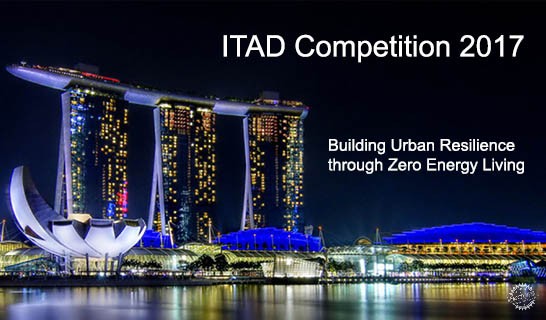
International Tropical Architecture Design Competition 2017
由专筑网缕夕,刘庆新编译
建筑竞赛:2017国际热带建筑设计竞赛
提交:2017年7月7日
报名:2017年6月9日
语言:英语
地点:概念
奖品:一等奖:5000新加坡元,二等奖:3000新加坡元,三等奖:2000新加坡元,优异奖两名800新加坡元,荣誉提名
类型:开放型
80%的大城市容易遭受自然灾害的严重影响,所有城市都面临气候变化带来的新的考验。过去十年来,自然灾害影响了2.2亿多人,造成每年1亿美元的经济损失。
随着气候不断变化,灾害带来的不利影响增加,迫切需要城市具有弹性。城市的弹性是无论他们经历什么样的慢性压力和急性冲击,一个城市内的个人,社区,机构,企业和制度的生存、适应和发展的能力。
城市是一个复杂体系,有着高度相互依赖的制度,其人民和企业的发展依赖基础设施网络、通信系统等。投资和建设城市的韧性有助于后代的长期可持续发展。
在建设有限的城市环境中,绿色建筑对于可持续发展至关重要。根据联合国环境规划署(UNEP)的统计,建筑物占全球能源的40%左右,占全球水资源的25%,占全球资源的40%,排放量约为温室气体排放量的1/3。通过有效设计和综合技术,诸如零能源建筑等开发项目有可能减少碳排放以提高气候恢复能力。它们产生足够的能量来运行,从而减少对有限资源的依赖。
目标
今年的竞赛寻求创新——有影响力和实用的设计解决方案,将零消耗建筑融入城市使用者的选择,同时适当考虑能源恢复力、环境可持续性和快速城市化等领域去应对全球挑战。他们所在的建筑物和社区应该在自然灾害和社会经济危机的时候能促进可持续发展和城市弹性。应该考虑到建筑物与社区融为一体,以及如何影响/参与居住者/使用者对建筑物,使其可持续性发挥积极作用。建筑类型不限制,但必须是中层(6-12层)或高层(13层以上)建筑。
设计要求
满足以下条目:
- 结合主动和被动设计策略,节能功能和其他绿色建筑功能
- 以绿色建筑要求作为评估基础,验证其可持续设计理念。
- 除了外部建筑设计,还应该考虑建筑内部如何纳入以用户为中心的可持续发展功能和实践,包括评估对居民/用户的整体福利的影响
- 结合设计概念/元素,鼓励/指导居民/最终使用者在热带气候中培养绿色习惯或做法
- 根据当前的资源,为未来的住宅建筑提供切实可行的方向
Submission: July 07, 2017
Registration: June 09, 2017
Language: English
Location: Concept
Prizes: 1st Prize: 5,000 SGD, 2nd Prize: 3,000 SGD, 3rd Prize: 2,000 SGD, 2 Merit Prizes 800 SGD each, Special Mention
Type: Open
80 percent of the largest cities are vulnerable to severe impacts from natural disasters and all cities face new impacts caused by climate change. Over the last decade, natural disasters affected more than 220 million people and caused economic damage of USD $100 million per year.
As climate continues to change and the adverse impacts of disasters increase in cities, there is an imminent need for urban cities to be resilient. Urban resilience is the capacity of individuals, communities, institutions, businesses and systems within a city to survive, adapt,and grow no matter what kind of chronic stresses and acute shocks they experience.
Urban cities are complex with highly interdependent systems, where its people and enterprises are dependent on infrastructure networks, communication systems etc. for their well-being. Investing in building up cities’ resilience contributes to long-term sustainability for future generations.
In a built-up urban environment where land space is limited, green buildings are vital to sustainability. According to United Nations Environment Programme (UNEP), buildings use about 40% of global energy, 25% of global water, 40% of global resources, and they emit approximately 1/3 of Green House Gases (GHG) emissions. Through effective design and incorporation of technology, developments such as Zero Energy buildings have great potential to reduce its carbon footprint for greater climate resilience. They produce enough energy to run by itself, thereby reducing its reliance on limited resources.
AIM
This year’s competition seeks innovative, impactful and practical design solutions to integrate Zero Energy buildings in an urban city of participant’s choice, with due consideration to combat global challenges in areas such as energy resilience, environmental sustainability and rapid urbanisation. The buildings and the communities which they house should promote sustainability and urban resilience in times of natural disasters and socio-economic challenges. Considerations should be given to the cohesive integration of the building in the community and how occupants/users can be influenced/engaged to play an active role towards the sustainability of the building. There is no restriction on building typology, but it has to be a medium-rise (between 6-12 storey) or a high-rise (above 13 storey) building.
DESIGN REQUIREMENTS
Entries should:
- Be applicable for the tropical/sub-tropical climate
- Identify a city for the design of the building to be based on
- Incorporate both active and passive design strategies, energy efficient features and other green building features
- Be based on BCA Green Mark assessment tool to validate their sustainable design concepts.
- Justify how the features and strategies contribute to the sustainability of the building
- Include the engineering feasibility of the design solutions proposed, where possible
- Other than the exterior building design, considerations should also be given to the building interior on how user-centric sustainable features and practices can be incorporated, including an evaluation of the effect on the overall well-being of building residents/users
- Design should also show how the proposed building can integrate with the surrounding environment and landscape
- Incorporate design concepts/elements that will encourage/guide residents/ end-users to cultivate green behaviours or practices in the tropical climate
- Present a practical, feasible direction for future residential buildings, based on resources available in present day
- Design board should include site plans and cross-sections perspectives
出处:本文译自competitions.archi/,转载请注明出处。
|
|
